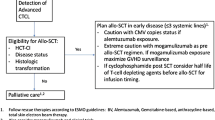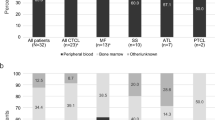Abstract
In our retrospective study, 16 patients affected by advanced cutaneous T cell lymphoma (CTCL) underwent allogeneic hematopoietic stem cell transplantation (HSCT). Two patients (12.5%) were in complete remission (CR), nine (56.3%) in partial remission (PR), and five (31.2%) with active disease. The patients were transplanted from an HLA-identical (n = 7) from a mismatched (n = 1) or haploidentical (n = 1) sibling, from matched unrelated donor (n = 5), or from a single cord blood unit (n = 2). Conditioning regimen was standard myeloablative in 6 patients and at reduced intensity in 10. Seven patients died from non relapse mortality (NRM) and four patients relapsed or progressed, three of them achieved a second CR after donor lymphocyte infusion (DLI) or chemotherapy plus DLI. To date, with a median follow-up of 76 months (range 6–130), nine patients are alive, eight in CR, and one with active disease. Overall survival (OS) and disease-free survival (DFS) at 1 and 10 years are 61% (95% CI 40–91%) and 54% (95% CI 33–86%), 40% (95% CI 22–74%), and 34% (95% CI 16–68%), respectively. The time from diagnosis to transplant seems to influence negatively both OS (log-rank p < 0.04) and DFS (log-rank p < 0.05). Our results confirm on a long follow-up that CTCL appears particularly susceptible to the graft versus lymphoma (GVL) effect, so that allogeneic HSCT represents a possibility of cure for advanced CTCL. The timing of HSCT in the clinical course of disease remains an open issue.


Similar content being viewed by others
References
Bradford PT, Devesa SS, Anderson WF, Toro JR (2009) Cutaneous lymphoma incidence patterns in the United States: a population-based study of 3884 cases. Blood 113:5064–5073
Willemze R, Jaffe ES, Burg G, Cerroni L, Berti E, Swerdlow SH (2005) WHO-EORTC classification for cutaneous lymphomas. Blood 105:3768–3785
Olsen E, Vonderheid E, Pimpinelli N, Willemze R, Kim Y, Knobler R, Zackheim H, Duvic M, Estrach T, Lamberg S, Wood G, Dummer R, Ranki A, Burg G, Heald P, Pittelkow M, Bernengo MG, Sterry W, Laroche L, Trautinger F, Whittaker S, ISCL/EORTC (2007) Revisions to the staging and classification of mycosis fungoides and Sezary syndrome: a proposal of the International Society for Cutaneous Lymphomas (ISCL) and the cutaneous lymphoma task force of the European Organization of Research and Treatment of Cancer (EORTC). Blood 110:1713–1722
Kim YH, Willemze R, Pimpinelli N, Whittaker S, Olsen EA, Ranki A, Dummer R, Hoppe RT, ISCL and the EORTC (2007) TNM classification system for primary cutaneous lymphomas other than mycosis fungoides and Sezary syndrome: a proposal of the International Society for Cutaneous Lymphomas (ISCL) and the Cutaneous Lymphoma Task Force of the European Organization of Research and Treatment of Cancer (EORTC). Blood 110:479–484
Jawed SI, Myskowski PL, Horwitz S, Moskowitz A, Querfeld C (2014) Primary cutaneous T-cell lymphoma (mycosis fungoides and Sézary syndrome): part I. Diagnosis: clinical and histopathologic features and new molecular and biologic markers. J Am Acad Dermatol 70:223e1–22317
Quintanilla-Martinez L, Jansen PM, Kinney MC, Swerdlow SH, Willemze R (2013) Non-mycosis fungoides cutaneous T-cell lymphomas: report of the 2011 Society for Hematopathology/European Association for Haematopathology Workshop. Am J Clin Pathol 139:491–514
Whittaker S, Hoppe R, Prince MH (2016) How I treat mycosis fungoides and Sezary syndrome. Blood 127:3142–3153
Horwitz SM, Olsen EA, Duvic M, Porcu P, Kim YH (2008) Review of the treatment of mycosis fungoides and Sezary syndrome: a stage-based approach. J Natl Compr Cancer Netw 6:436–442
Willemze R, Hodak H, Zinzani PL, Specht L, Ladetto M, on behalf of the ESMO Guidelines Working Group (2013) Primary cutaneous lymphomas: ESMO Clinical Practice Guidelines for diagnosis, treatment and follow-up. Ann Oncol 24(Supplement 6):vi149–vi154
Jawed SI, Myskowski PL, Horwitz S, Moskowitz A, Querfeld C (2014) Primary cutaneous T-cell lymphoma (mycosis fungoides and Sezary syndrome): part II. Prognosis, management and future directions. J Am Acad Dermatol 70:205e1–20516
Ingen-Housz-Oro S, Bachelez H, Verola O, Lebbé C, Marolleau JP, Hennequin C, Dubertret L, Morel P, Gisselbrecht C, Brice P (2004) High-dose therapy and autologous stem cell transplantation in relapsing cutaneous lymphoma. Bone Marrow Transplant 33:629–663
Molina A, Zain J, Arber DA, Angelopolou M, O’Donnell M, Murata-Collins J, Forman SJ, Nademanee A (2005) Durable clinical, cytogenetic, and molecular remissions after allogeneic hematopoietic cell transplantation for refractory Sezary syndrome and mycosis fungoides. J Clin Oncol 23:6163–6171
Herbert KE, Spencer A, Grigg A, Ryan G, McCormack C, Prince HM (2004) Graft versus lymphoma effect in refractory cutaneous T cell lymphoma after reduced intensity HLA matched sibling allogeneic stem cell transplantation. Bone Marrow Transpl 34:521–525
Soligo D, Ibatici A, Berti E, Morandi P, Longhi E, Venegoni L, Corbellino M, Annaloro C, Robbiolo L, Della Volpe A, Alessi E, Lambertenghi Deliliers G (2003) Treatment of advance mycosis fungoides by allogeneic stem-cell transplantation with a nonmyeloablative regimen. Bone Marrow Transplant 31:663–666
Duarte RF, Canals C, Onida F, Gabriel IH, Arranz R, Arcese W, Ferrant A, Kobbe G, Narni F, Deliliers GL, Olavarría E, Schmitz N, Sureda A (2010) Allogeneic hematopoietic cell transplantation for patients with mycosis fungoides and Sézary syndrome: a retrospective analysis of the Lymphoma Working Party of the European Group for blood and bone marrow transplantation. J Clin Oncol 28:4492–4499
Di Bartolomeo P, Santarone S, De Angelis G, Picardi A, Cudillo L, Cerretti R et al (2013) Haploidentical, unmanipulated, G-CSF–primed bone marrow transplantation for patient with high-risk hematologic malignancies. Blood 21:857–849
Przepiorka D, Weisdorf D, Martin P, Klingemann HG, Beatty P, Hows J, Thomas ED (1995) 1994 Consensus conference on acute GVHD grading. Bone Marrow Transplant 15:825–828
Filipovich AH, Weisdorf D, Pavletic S, Socie G, Wingard JR, Lee SJ, Martin P, Chien J, Przepiorka D, Couriel D, Cowen EW, Dinndorf P, Farrell A, Hartzman R, Henslee-Downey J, Jacobsohn D, McDonald G, Mittleman B, Rizzo JD, Robinson M, Schubert M, Schultz K, Shulman H, Turner M, Vogelsang G, Flowers MED (2005) National Institutes of Health consensus development project on criteria for clinical trials in chronic graft-versus-host-disease: I. Diagnosis and staging working group report. Biol Blood Marrow Transplant 11:945–956
Kaplan EL, Meier P (1958) Non parametric estimation for incomplete observation. J Am Stat Assoc 53:457–481
Gooley TA, Leisenring W, Crowley J, Storer BE (1999) Estimation of failure probabilities in the presence of competing risks: new representations of old estimators. Stat Med 18:695–706
Gray RJ (1988) A class of K-sample tests for comparing the cumulative incidence of a competing risk. Ann Stat 16(3):1141–1154
Cudillo L, Cerretti R, Baliva G, De Angelis G, Postorino M, Picardi A et al (2009) Sezary syndrome in relapse after reduced intensity allogeneic transplant successfully treated with donor lymphocyte infusion. Bone Marrow Transplant 43:347–348
Paralkar VR, Nasta SD, Morrissey K, Smith J, Vassilev P, Martin ME, Goldstein SC, Loren A, Rook AH, Kim EJ, Porter DL (2012) Allogeneic hematopoietic SCT for primary cutaneous T cell lymphomas. Bone Marrow Transplant 47:940–945
Duvic M, Donato M, Dabaja B, Richmond H, Singh L, Wei W, Acholonu S, Khouri I, Champlin R, Hosing C (2010) Total skin electron beam and non-myeloablative allogeneic hematopoietic stem-cell transplantation in advanced mycosis fungoides and Sezary syndrome. J Clin Oncol 28:2365–2237
de Masson A, Beylot-Barry M, Bouaziz JD, Peffault de Latour R, Aubin F, Garciaz S, French Study Group on Cutaneous Lymphomas and Société Française de Greffe de Moëlle et Thérapie Cellulaire et al (2014) Allogeneic stem cell transplantation for advanced cutaneous T-cell lymphomas: a study from the French Society of Bone Marrow Transplantation and French Study Group on Cutaneous Lymphomas. Haematologica 99:527–534
Lechowicz MJ, Lazarus HM, Carreras J, Laport GG, Cutler CS, Wiernik PH, Hale GA, Maharaj D, Gale RP, Rowlings PA, Freytes CO, Miller AM, Vose JM, Maziarz RT, Montoto S, Maloney DG, Hari PN (2014) Allogeneic hematopoietic cell transplantation for mycosis fungoides and Sezary syndrome. Bone Marrow Transplant 49:1360–1365
Duarte RF, Boumendil A, Onida F, Gabriel I, Arranz R, Arcese W, Poiré X, Kobbe G, Narni F, Cortelezzi A, Olavarría E, Schmitz N, Sureda A, Dreger P (2014) Long-term outcome of allogeneic hematopoietic cell transplantation for patients with mycosis fungoides and Sezary syndrome: a European society for blood and marrow transplantation lymphoma working party extended analysis. J Clin Oncol 32:3347–3348
Hosing C, Bassett R, Dabaja B, Talpur R, Alousi A, Ciurea SF et al (2015) Allogeneic stem-cell transplantation in patients with cutaneous lymphoma: updated results from a single institution. Ann of Oncol 26:2490–2495
Brownell I, Etzel CJ, Yang DJ, Taylor SH, Duvic M (2008) Increased malignancy risk in the cutaneous T-cell lymphoma patient population. Clin Lymphoma Myeloma 8:100–105
Author information
Authors and Affiliations
Consortia
Corresponding author
Ethics declarations
All procedures performed were in accordance with the ethical standards of the responsible committee on human experimentation (institutional and national) and with the Helsinki Declaration of 1975, as revised in 2008.
All patients provided written informed consent for being included in the transplant procedure.
Conflict of interest
The authors declare that they have no conflict of interest.
Rights and permissions
About this article
Cite this article
Cudillo, L., Cerretti, R., Picardi, A. et al. Allogeneic hematopoietic stem cell transplantation in Primary Cutaneous T Cell Lymphoma. Ann Hematol 97, 1041–1048 (2018). https://doi.org/10.1007/s00277-018-3275-z
Received:
Accepted:
Published:
Issue Date:
DOI: https://doi.org/10.1007/s00277-018-3275-z




